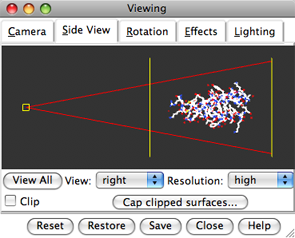
Many tasks in Chimera can be accomplished in multiple ways. For example, colors and display styles can be changed with the Actions menu or by entering commands. In general, commands are much more concise and powerful, but menus allow easy access to features without requiring knowledge of commands and their syntax.
In this tutorial, many of the same tasks performed with commands in the Getting Started Tutorial - Command Version are carried out using the menus instead.
To follow along, first download the PDB files included with this tutorial to a convenient location on your computer:
On Windows/Mac, click the chimera icon; on UNIX, start Chimera from the system prompt:
unix: chimeraA splash screen will appear, to be replaced in a few seconds by the main Chimera window. If you like, resize the Chimera window by dragging its lower right corner.
Now open a structure. Choose File... Open from the menu and use the resulting file browser to locate and open the previously downloaded file 1zik.pdb (the File type should be set to all (guess type) or PDB). The structure is a leucine zipper formed by two peptides.
A preset is a predefined combination of display settings. Apply interactive preset #2, which displays all atoms and colors the heteroatoms by element:
Presets... Interactive 2 (all atoms)
 |
Use the Favorites menu to show the Side View. Each window or tool can be moved to a convenient location by clicking its top bar and dragging.
The Side View allows interactive scaling (zooming) and clipping. It shows a tiny version of the structure. Within the Side View, try moving the eye position (the small square) and the clipping planes (vertical lines) with the left mouse button. The Side View will renormalize itself after movements, so that the eye or clipping plane positions may appear to "bounce back," but your adjustments have been applied.
Try moving the structure with the mouse in the main graphics window. By default, the left mouse button controls rotation and the middle mouse button controls XY translation. Continue moving and scaling the structure with the mouse in the graphics window and Side View as desired throughout the tutorial.
Hovering the mouse cursor over an atom or bond (without clicking any buttons) will show identifying information in a pop-up "balloon." The balloon will disappear when the cursor is moved away.
In Chimera, selection specifies atoms, bonds, residues, etc. for subsequent operations with the Actions menu. Ways to make a selection include using the Select menu or picking from the screen. The Actions menu applies to whatever is selected, but when nothing is selected, the Actions menu applies to everything.
Hide the water (red dots):
Select... Structure... solventAlternatively, the water could have been selected using Select... Residue... HOH. Even though the water is hidden, it is still selected.
Actions... Atoms/Bonds... hide
Clear the selection and display only the chain trace:
Select... Clear SelectionThe chain trace includes just the α-carbons (atoms named CA), connected in the same way that the residues are connected.
Actions... Atoms/Bonds... backbone only... chain trace
By default, picking from the screen is done by clicking on the atom or bond of interest with the left mouse button while holding down the Ctrl key. To add to an existing selection, also hold down the Shift key. Try picking two atoms, one from each peptide (Ctrl-click the first, Ctrl-Shift-click the second). The selection is highlighted in green, and its contents are reported on the button near the lower right corner of the main window.
Label the atoms you have selected, first by atom name and then by residue name and number:
| residue labels |
|---|
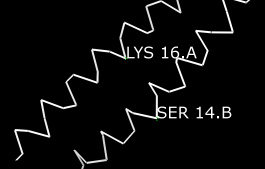 |
Actions... Label... nameEach residue label is of the form:
Actions... Label... off
Actions... Label... residue... name + specifier
res_name res_number.chainOne peptide is chain A and the other is chain B. Clear the selection and undisplay the residue labels:
Select... Clear Selection(Another way to clear a selection is to Ctrl-click in empty space.) Color the two chains different colors:
Actions... Label... residue... off
Select... Chain... ARepeat the process to color chain B yellow.
Actions... Color... cyan
Select chain A by picking any atom or bond in the chain, then hitting the up arrow key twice, once to expand the selection to the entire residue and another time to expand it to the entire chain. Display its full backbone:
Actions... Atoms/Bonds... backbone only... fullDisplay all atoms of chain A only (which is still selected):
Actions... Atoms/Bonds... show only
| coloring by element |
|---|
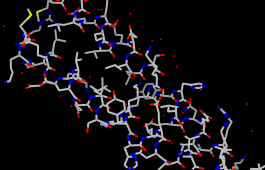 |
Display all atoms and color them by element:
Select... Clear SelectionThe by element coloring applies to all elements including carbon (gray), whereas by heteroatom coloring (as in the preset used near the beginning of the tutorial) leaves carbons unchanged. Heteroatom-only coloring is especially useful for keeping multiple structures with different default colors distinguishable.
Actions... Atoms/Bonds... show
Actions... Color... by element
Generally, each file of coordinates opened in Chimera becomes a model with an associated model ID number. Models are assigned successive numbers starting with 0. Models are listed in the left side of the Model Panel (Tools... General Controls... Model Panel). A checkbox in the A(ctive) column of the Model Panel shows that the model is activated for motion; unchecking the box makes it impossible to move the model. Checking the box again restores the movable state. Make sure 1zik.pdb is highlighted on the left side of the Model Panel (if not, click on it) and then click close in the list of functions on the right side. Next, use the Close button at the bottom to close the Model Panel.
Go on to Part 2 below, OR exit from Chimera with File... Quit.
With Chimera started and the Side View opened as described at the beginning of Part 1, choose the menu item File... Open. Use the resulting file browser to locate and open the previously downloaded file 1d86.pdb (the File type should be set to all (guess type) or PDB). It contains the molecule netropsin bound to double-helical DNA.
Use the "all atoms" preset, which will show the DNA as wire and netropsin as spheres:
Presets... Interactive 2 (all atoms)Undisplay the water:
Select... Structure... solventRemember that hiding atoms does not deselect them; they remain selected until the selection is cleared or replaced with a new selection.
Actions... Atoms/Bonds... hide
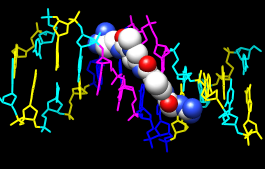 |
Color the different nucleotides different colors. For example, color the adenine deoxynucleotides blue:
Select... Residue... DAAnalogously, color cytosine deoxynucleotides (DC residues) cyan, guanine deoxynucleotides (DG residues) yellow, and thymine deoxynucleotides (DT residues) magenta. Clear the selection with Select... Clear Selection or by picking in empty space.
Actions... Color... blue
Rotate, translate, and scale the structure as needed to get a better look (see mouse manipulation to review how this is done). Continue moving and scaling the structure as desired throughout the tutorial.
Next, try some different display styles, or representations. Multiple styles can be combined with each other and with surfaces (more on surfaces below).
 |
Actions... Ribbon... showChange the representation of only one of the DNA strands:
Actions... Ribbon... edged
Actions... Ribbon... rounded
Actions... Ribbon... hide
Actions... Atoms/Bonds... stick
Actions... Atoms/Bonds... sphere
Select... Chain... ANext, change everything to a ball-and-stick representation:
Actions... Atoms/Bonds... stick
Select... Clear Selection
Actions... Atoms/Bonds... ball & stickCtrl-click to pick one of the atoms in netropsin. Label the residue,
Actions... Label... residue... nameshowing that it is named NT. The residue label might not be near the selected atom. The first submenu under Label controls individual atom labels, while the second controls residue labels. Actions... Label... name would have shown the name of the atom instead of the name of the residue.
Clear the selection (for example, with Ctrl-click in empty space) and undisplay the residue label:
Actions... Label... residue... off
 |
Finally, have some fun with surfaces. There are built-in categories within structures such as main and ligand; when nothing is selected, Actions... Surface... show displays the surface of main.
Actions... Surface... showSurface color can be specified separately from the colors of the underlying atoms. Change the surface color only of netropsin (which is still selected):
Actions... Surface... hide
Select... Structure... ligand
Actions... Surface... show
Actions... Surface... mesh
Clear the selection, change back to a solid surface, and then undisplay the surface.
- change the coloring target: Actions... Color... surfaces
- Actions... Color... red
- restore the default coloring target: Actions... Color... all of the above
Select... Clear Selection
Actions... Surface... solid
Actions... Surface... hide
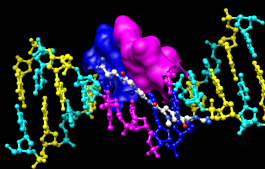 |
To prepare for any subsequent operations, restore the selection mode and clear the selection:
- change the selection mode: Select... Selection Mode... append
- Select... Residue... DA
- Select... Residue... DT
- change the selection mode: Select... Selection Mode... intersect
- Select... Chain... B
- Actions... Surface... show
Select... Selection Mode... replaceThe command equivalent is much more concise, but requires some knowledge of the atom specification syntax:
Select... Clear Selection
Command: surf :da.b,dt.b
Sometimes it is helpful to make a solid surface transparent:
Actions... Surface... transparency... 50%Choose File... Quit from the menu to terminate the Chimera session.